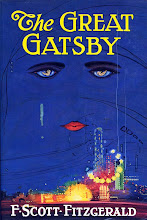Theme In Relation To The Great Gatsby:
Honors Extension
The central tension in the
novel deals with Gatsby and the world in which he lives. For we cannot ignore
the obvious textual evidence, even if we want to contrast Gatsby with the
society he inhabits, that he shares at least some of its corruption; for
example, he was Wolfsheim’s protégé where he made his fortune. Between the
world of the corrupt, vulgar materialism portrayed in the novel and the lyrical
imagery—the wistful beauty and emotional force of which make it the most
memorable and revealing dimension of the novel—so frequently used to describe
that world. This tension structures the narrative regardless of how we measure
the relative innocence or corruption of any particular character, and it is
resolved by a theme of universal human significance that transcends the
historical period in which the novel is set: the theme that unfulfilled longing is part of the human condition,
common to all and inescapable. The imagery of unfulfilled longing is
used to describe characters and settings regardless of wealth or poverty,
refinement or vulgarity, corruption or innocence they represent. In addition,
the imagery of unfulfilled longing is as inevitable as the change of seasons.
Finally, the imagery of unfulfilled longing often has a static, timeless
quality in the novel, which underscores both its universality and its
inevitability; unfulfilled longing
has always been and always will be a part of the human condition.
The imagery of unfulfilled
longing weaves a common thread through characters that represent very different
elements of society. Fitzgerald’s lyric imagery informs characterization
through the novel in three ways; (1) nostalgia for a lost past; (2) as dreams
of future fulfillment; and (3) as vague, undefined longing that has no specific
goal.
(1) Consider Jordan, Nick, and Tom
(2) Consider Gatsby and Nick
(3) Consider Myrtle and Tom with their NYC
world/apartment. Gatsby’s parties and Nick’s narration of them. How does the
setting conflict with the vulgarity? Also, consider Gatsby and Daisy. How does
Nick’s narrative quote, “held Gatsby most with its fluctuating, feverish warmth
because it couldn’t be over-dreamed,” (Ch. 5) contribute to this? Also include,
“It occurred to me that he had been very slowly bending toward her all evening
to attain this proximity.” (Ch. 6) Finally, he (Nick) “was overwhelmingly aware
of the youth and mystery that wealth imprisons and preserves” (Ch. 8).
ASSIGNMENT: Using this theme as your thesis statement and the three methods of proof provided, construct an outline using the three (3) uses of lyric imagery to inform characterization. You have the tools for consideration and now you have to find the examples within the novel. DUE NEXT BLOCK.
